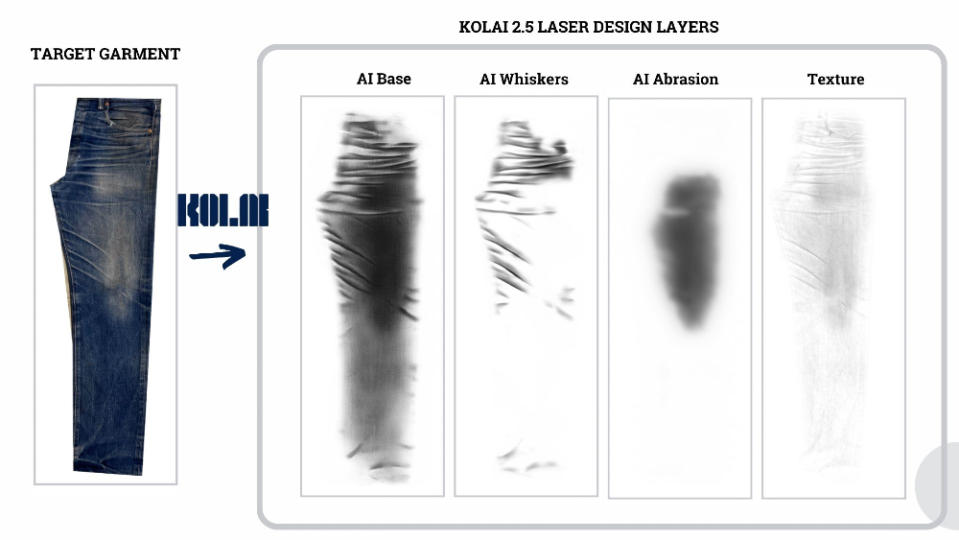What KolAI Denim Offers Manufacturers, Laundries and Brands

Recent high-profile advancements in AI technology could ripple out to the denim industry before long.
Artificial intelligence has powered KolAi Denim’s signature product—a platform that turns photos into denim laser designs—since KolAi Designer hit the market in 2021. Though its creators are still improving the product’s functionality, rolling out a new update just last week, their end goal is to make something that can smoothly translate brand and designer input into designs.
More from Sourcing Journal
What 59% of Klarna's Study Group Says About Robots in Retail
Rebecca Minkoff on Quality Control: 'Sometimes There Are No Shortcuts'
Disruption Scared Half of Supply Chain Execs Into Investing to 'Weather the Storm'
The idea for KolAi—a play on “kolay,” the Turkish word for “easy” and AI—dates to 2016, when the company’s founders were all working either at or with VF Corp. The idea remained just that for another four years until the pandemic suddenly gave the three co-founders, CEO Kyle Stephens, chief technology officer Jack Payne and chief operations officer Aydin Tuna Palabiyikoglu, the time they needed to create what would become KolAi Denim.
After a year of trial and error, they finally had a product they were ready to roll out to the public. KolAi Denim slowly picked up a few customers that first year, learning from them along the way, Stephens said. In 2022, it began attracting “a lot more” customers, a trend that has continued into this year, the CEO added.
These customers are generally manufacturers and laundries, such as Crystal International Group in Hong Kong. The Southern California company also works with “some major brands” as well, Stephens said. KolAi’s website includes a testimonial from Guess Jeans USA’s laundry manager, but the CEO said he could not disclose any other brand names.
At its most basic level, KolAi Denim’s platform is designed to simplify the process by which a factory takes a brand sample and turns it into a file that a laser machine will understand. Using a simple cell phone—any phone from the past three or four years will do, Palabiyikoglu said—manufacturers simply take a photo of the brand sample and upload that image to KolAi Designer. In a matter of minutes, the AI turns that image into a laser design. Rolled out May 8, the platform’s latest update now separates that laser design into different layers.
“The way that designers like to work is in Photoshop to do layer by layer,” Stephens said. “So, this whiskers on this layer, this whiskers on another layer. All the design elements are split up. And they like to work that way because if the customer, the brand comes and says ‘Okay, remove this element,’ they can just hide that layer in Photoshop, or ‘Make this one more intense,’ they can just adjust just that layer. So that’s what our new update is. Now we’re splitting everything layer by layer to work the way that designers like to work and make it easier for them to customize and do different things.”

This update, Stephens added, “was essentially an express request we got a number of times over the last few months especially.”
Looking ahead, Stephens said KolAi’s end goal is to create something that helps the designer visualize what they want in a way the manufacturer understands.
“Right now, there’s a lot of waste in the denim industry in particular, and a lot of that is because a denim designer has a hard time communicating exactly what they want to the factory,” he said. “So, they have mood boards, they have things, and they try their best to put that in a language that a factory can understand. But ultimately, the factory has to make a sample, send it to back around the world. The designer has to give comments. They go back and forth with it several times. A lot of that could be digitized and I think AI could help with that.”
Whereas popular newer AI programs like the language processing tool ChatGPT and the image generating platform Midjourney rely on user-provided text to create a final output, Stephens envisions that Los Angeles-area KolAi will continue to use samples as its starting point. From there, the idea would be to allow denim designers to type in changes, such as changing a patch pocket to a welt pocket. “Then the AI can generate an image and you can say, ‘Yes, that’s right,’ or ‘No, change it in this way,’ kind of like a digital assistant,” Stephens said.
“Most of the people working in AI aren’t considering applications in fashion, or at least not in denim in particular,” he added. “We’re kind of filling that hole. How can we customize these things people are building to make it really useful for people who are in denim.”
